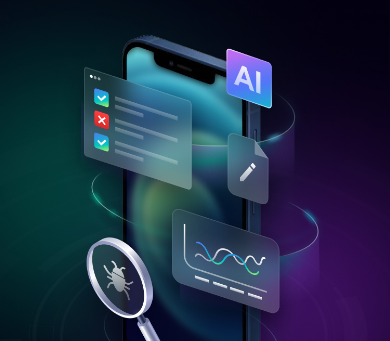Quality Assurance Metrics: Measuring Software Quality Effectively
Software development relies significantly on quality assurance (QA) to maintain its operational strength, which cannot be disregarded in this field. Quality assurance is essential to guarantee that software systems achieve both necessary specifications and operational intent. Software systems are becoming progressively complex; thus, the requirement for generating accurate assessments of software quality has become essential. Quality assurance metrics take center stage to fulfill their objective. Quality assurance metrics that systematically monitor project development processes allow organizations to uphold high-quality standards while minimizing risks and delivering software products that fulfill user specifications.
The following article examines QA metrics, starting with their definition and then examining their importance. An overview of trackable types follows it before explaining their use to enhance software quality delivery.
What Are QA Metrics?
Quality Assurance (QA) metrics function as numerical indicators that assess the software development process for its effectiveness and efficiency and its professional quality standards. Development teams utilize these metrics to determine the software’s operational status and flaw points and confirm the match between end products, expressed requirements, and anticipated user needs.
QA metrics can be divided into two broad categories:
- Process Metrics: Technical processes are evaluated through metrics that measure the efficiency of operations. These include defect density assessment and testing efficiency metrics. Code complexity is another processed metric.
- Product Metrics: Product metrics measure the quality elements of the software product, assessing functionality alongside reliability and performance.
Regular assessment of these metrics from software development from start to finish allows organizations to guarantee their products achieve top-notch quality standards with no critical bugs while performing accordingly in operational environments.
Why Are QA Metrics Important?
QA metrics offer numerous benefits, making them an essential component of software development. Let’s explore some key reasons why QA metrics are vital:
1. Objective Measurement of Software Quality
Subjective and inconsistent software quality assessment becomes possible when no metrics exist to measure it. Tests that use quality metrics offer an automated approach for software product evaluation, thus allowing for better progress assessment and the formulation of efficient improvement strategies.
2. Improved Decision Making
The application of QA metrics allows stakeholders and teams to base their decision-making on actual real-time insights. For example, the team chooses to handle severe bug problems first when defect density measures show high numbers. The evidence derived from metrics gives teams the needed data to make these choices.
3. Predictability
Teams who study past data alongside time-based trends will obtain enhanced capability to predict what will happen in their future projects. Previous release defect analysis enables project teams to forecast both defect occurrence numbers and the required fixed time for the current development cycle.
4. Early Identification of Problems
Debugging problems within the development process becomes possible through QA metrics, which alert teams to resolve issues early to prevent accelerated problems. Detecting software issues caused by bad code quality and poor test coverage leads to savings of resources and time within the development process.
5. Continuous Improvement
Software development, at its core, adopts continuous improvement as a principle, and QA metrics represent its core foundation. Teams enhance their development process and product quality through ongoing metric review and analysis techniques, which leads them to adopt best practices for improving their work.
6. Enhanced Collaboration and Communication
Quality metrics help create more efficient communication between team members and between developers and external stakeholders. QA metrics enable developers, testers, and managers to evaluate the software’s current status and quality together with progress updates through objective metrics data, thus enabling better decisions.
7. Resource Allocation and Planning
Quality assessment metrics enable organizations to distribute their resources effectively. Teams can detect where more attention is needed by monitoring their time handling defects and the efficiency of testing activities. High defect frequencies in particular module areas should trigger both added testing steps and refactoring processes. The use of metrics lets organizations allocate their resources effectively, so development becomes more efficient.
8. Risk Management
The earliest development phase depends heavily on QA metrics to discover potential risks and control their management. By monitoring defect density combined with test coverage metrics, teams discover possible issues that they tackle prior to extensive growth. The presence of numerous defects within a module indicates increased risk levels that require additional inspection or review work to prevent problems at release time.
Types of QA Metrics to Measure Software Quality
Multiple metrics exist to track software quality, and selection depends on project objectives and the current development phase. The following list includes essential QA metrics that developers and testers should monitor:
1. Defect Density
Defect density analysis provides critical information about the number of defects found in a coded unit by measuring defects per thousand lines of code (KLOC). Through defect density metrics, teams can determine the overall program quality while detecting spots with elevated risk.
How to calculate defect density:
Defect Density=Number of DefectsSize of Code (in KLOC)\text{Defect Density} = \frac{\text{Number of Defects}}{\text{Size of Code (in KLOC)}}
High defect densities often indicate weak code quality and inadequate testing. A lower defect density generally indicates better code quality.
2. Test Coverage
Test coverage indicates how much of a software’s code gets evaluated by manual or automated tests, which is expressed as a percentage. JUnit testing, a widely used framework for unit testing in Java, is often employed to automate testing and improve test coverage. Testing all available code improves software quality through the increased screening of potential bugs across more application areas.
Types of test coverage:
- Code Coverage: It outlines the metric that describes how much code testing has reached execution status.
- Branch Coverage: This measurement indicates the percentage of control decision points known as branches that receive testing applications.
- Path Coverage: The percentage measure describing how many execution routes through the software have received testing counts as Path Coverage.
A coverage threshold of 80% typically indicates good testing standards, though a 100% coverage rating fails to confirm complete bug-free software. The assessment process must test both uncommon situations and practical circumstances.
3. Defect Resolution Time
The average duration of resolving registered defects is defect resolution time. Measuring defect resolution time shows issue response speed and helps assess quality preservation while working at an appropriate pace.
How to calculate defect resolution time:
Defect Resolution Time=Total Time to Resolve DefectsNumber of Defects Resolved\text{Defect Resolution Time} = \frac{\text{Total Time to Resolve Defects}}{\text{Number of Defects Resolved}}
For optimum results, defect resolution should occur swiftly, yet the solutions must provide complete resolutions without generating additional problems.
4. Escaped Defects
A defect that successfully advances to the production stage becomes an escaped defect after completing its testing phase. The metric assists teams in measuring their testing process effectiveness, which indicates that additional testing needs or alternative approaches should be considered.
How to calculate escaped defects:
Escaped Defects=Number of Defects Found in ProductionTotal Number of Defects Found\text{Escaped Defects} = \frac{\text{Number of Defects Found in Production}}{\text{Total Number of Defects Found}}
The best outcome comes from minimal defects that escape testing phases.
5. Customer-Reported Defects
Customer-reported defects are bugs or issues that end users report after the software has been released. While this metric is primarily concerned with post-release software quality, it’s an important indicator of how well the software performs in real-world conditions.
Why this metric is important:
Customer-defected tracking enables development teams to comprehend user-reported issues, which guides their improvement strategies for upcoming releases. Where numerous defects reported by customers exist, it becomes apparent that either the testing failed to meet standards or the users found the product lacking functionality.
6. Cycle Time
Cycle time represents the duration needed to finish a software development task between coding testing and bug resolution activities. Short pattern durations during software development indicate efficient process performance, but longer periods could indicate operational problems or unwanted inefficiencies.
How to calculate cycle time:
Cycle Time=Time Taken to Complete Task−Time Task Was Started\text{Cycle Time} = \text{Time Taken to Complete Task} – \text{Time Task Was Started}
Teams that track cycle time will use this method to find delays in their workflows, which leads to improved workflow optimization.
7. Defect Severity
Software defect severity determines how many problems disrupt the operational functionality of the software system. Software development faces function-limiting critical defects called high-severity defects alongside cosmetic problems and minor functional issues classified as low-severity defects.
Types of defect severity:
- Critical: The software’s performance fails completely, and critical issues occur because of critical defects.
- Major: A defect affecting substantial parts of the software system falls under the major category unless it creates complete operational failure.
- Minor: A minor defect impacts the software at a minimal level in terms of both performance and functionality.
Understanding defect severity helps prioritize which issues should be addressed first.
Best Practices for Using QA Metrics Effectively
Now that we’ve discussed the key QA metrics let’s look at some best practices for using these metrics effectively:
1. Set Clear Goals
Before tracking QA metrics, defining clear goals and objectives is essential. What aspects of software quality do you want to improve? Do you want to reduce defect density, improve test coverage, or minimize cycle time? Setting clear goals ensures the metrics you track align with your quality improvement efforts.
2. Don’t Rely on One Metric Alone
Software quality analysis depends on multiple QA metrics, but none fully clarify overall product quality. Multiple metrics should be combined to achieve a complete understanding of product quality.
3. Analyze Trends Over Time
QA metrics provide their best value when stakeholders conduct dynamic analysis across periods. You should monitor data development across time because this behavior reveals potential areas for quality enhancement. Shared defects within a specific module tend to indicate the necessity of performing code reviews or refactoring procedures.
4. Focus on the Root Cause
Metrics help highlight where problems exist but do not always explain why they occur. Using metrics enables you to start the process of comprehensive investigation. To understand why defect resolution time remains protracted, test planners should identify insufficient resource availability or communication issues and additional factors that could be responsible.
5. Use Metrics to Foster a Quality Culture
Metrics are not just tools for tracking performance; they should be used to foster a culture of quality within the team. Share metrics with all team members, encourage collaboration based on data and work together continuously to improve software quality.
- Incorporating Automated Testing
To improve efficiency and accuracy, integrating automated testing tools like LambdaTest can be highly beneficial. LambdaTest is an AI-native cloud-based platform for cross-browser testing, allowing teams to run tests across multiple browsers and OS without complex infrastructure.
This speeds up testing, improves test coverage, and helps detect issues earlier, ultimately enhancing software quality. Using LambdaTest alongside QA metrics ensures faster feedback, better decision-making, and more efficient development cycles.
In Conclusion
Quality assurance metrics serve as essential tools to evaluate and achieve software quality standards. Supply teams with important process analytics through defect density measurement test coverage detection and defect resolution tracking and escaped defects prevalence to deliver data-based quality enhancement decisions.
Successful application of QA metrics requires establishing clear objectives, selecting multiple metrics, examining time-based patterns, and pinpointing the origin of system problems. Organizations following best practices will enhance the developmental process and improve software product quality on an ongoing basis.
Organizations can deliver excellent software while building an environment of quality and ongoing development improvement through systematic software measurement that uses defined QA metrics.


